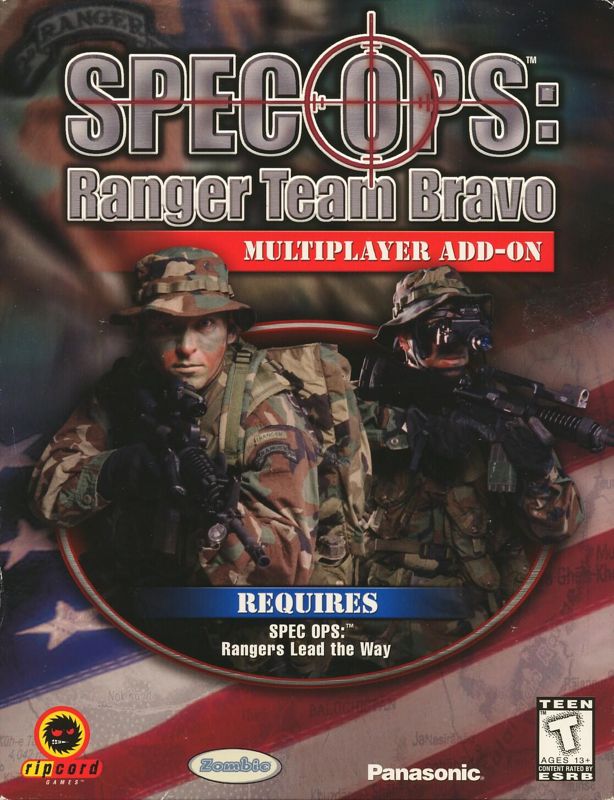Retro Replay Review
Gameplay
Spec Ops: Ranger Team Bravo expands the tactical shooting formula of Spec Ops: Rangers Lead the Way by introducing both cooperative and competitive multiplayer modes, alongside three new solo campaigns. The core gameplay loop retains the deliberate pacing and strategic positioning that defined the original, but now you can tackle objectives with friends in LAN or Internet matches. Team-based scenarios demand coordination—players must cover each other, revitalize downed comrades, and share ammo to push through enemy lines, adding a fresh layer of camaraderie to familiar mechanics.
(HEY YOU!! We hope you enjoy! We try not to run ads. So basically, this is a very expensive hobby running this site. Please consider joining us for updates, forums, and more. Network w/ us to make some cash or friends while retro gaming, and you can win some free retro games for posting. Okay, carry on 👍)
The competitive element ramps up the intensity with deathmatch matches for up to six players. These skirmishes blend classic run-and-gun firefights with the more methodical pace of Spec Ops, rewarding players who balance aggression with cover-based tactics. Weapon pickups are scattered across all existing and new levels, encouraging map mastery and strategic spawn-point control. While the AI in single-player can feel predictable at times, human opponents in multiplayer bring unpredictable engagements that demand quick thinking.
Beyond skirmishes, the three fresh campaigns—set in Bosnia, Vietnam ’68, and post-invasion Iraq—offer a diverse mission structure that ranges from stealthy reconnaissance to all-out assaults. Each theater features unique mission objectives, such as sabotaging supply convoys in Bosnia, navigating dense jungle traps in Vietnam, or securing urban strongholds in Iraq. The level design encourages multiple approaches, whether you choose to go in guns blazing or opt for a quieter insertion with suppressors and night-vision goggles.
Graphics
The graphics engine remains largely intact from its predecessor, but Ranger Team Bravo does tweak environments and textures to reflect each new setting. Bosnia’s mountainous villages showcase weathered stone walls and winding alleyways, while Vietnam ’68’s jungles are dense with foliage and muddy footpaths. In Iraq, the sun-baked cityscapes feature crumbling concrete buildings and billowing dust storms. Each locale feels distinct, thanks to thoughtfully placed environmental details and era-appropriate props.
Character models and weapon textures have seen minor refinements, with improved texture resolution on uniform fabrics, helmet decals, and weapon wear. Explosions and muzzle flashes look sharper, and smoke effects linger in the air, adding atmosphere to chaotic firefights. Lighting has been subtly enhanced in indoor environments, with feeble light bulbs, flickering neon signs, and muzzle-flash illumination contributing to immersion.
While the engine is showing its age by modern standards—vegetation clipping and occasional pop-in are still present—Team Bravo’s visual presentation holds up well for a late-90s release. The real triumph lies in how each campaign’s aesthetics reinforce the narrative and mood, from oppressive humid jungles to war-torn Middle Eastern streets. Overall, the graphical package serves both nostalgia and functional clarity during high-pressure engagements.
Story
Ranger Team Bravo’s narrative is delivered mission-by-mission rather than through a continuous campaign arc, but each three-mission thread provides a concise and evocative snapshot of conflict. Bosnia teases the early stages of the Balkan wars, Vietnam ’68 plunges you into classic counterinsurgency battles, and Iraq depicts urban warfare in a post-Gulf War scenario. Briefings before each mission supply historical context and objectives, grounding your actions in plausible military scenarios.
Voice acting ranges from serviceable to occasionally stiff, yet it does its job of conveying urgency and stakes. Ambient radio chatter, distress calls from civilians, and recorded enemy transmissions add to the sense of being a small unit operating behind enemy lines. Written intel snippets and in-game map briefings are concise but informative, giving players enough background without bogging down the action.
Although the add-on doesn’t strive for a deep emotional narrative or character development, the variety of mission types and settings keeps each campaign fresh. The lack of a recurring cast limits personal investment in characters, but the shifting geopolitical backdrops compensate by immersing you in real-world theaters of war. For fans of military shooters who prioritize tactical gameplay over cinematic storytelling, the narrative framework here is perfectly serviceable.
Overall Experience
Spec Ops: Ranger Team Bravo builds on the solid foundation of Rangers Lead the Way, delivering additional content that both solo players and multiplayer enthusiasts can appreciate. The new campaigns offer roughly three hours of fresh single-player action each, while the competitive and cooperative modes extend replay value by pitting you against real opponents. The requirement to own the original game is a minor inconvenience, but it ensures seamless integration of all existing levels and assets.
Multiplayer remains the highlight, especially when you find a stable group of teammates. Coordinated assaults, last-man-standing firefights, and objective-based matches all feel meaningful thanks to the engine’s emphasis on tactical movement and cover. Even without voice communication, gameplay cues like suppressed footsteps and directional gunfire allow informal teamwork. While modern online matchmaking infrastructures are absent—expect to set up your own LAN or host Internet matches via IP address—the community tools available still facilitate engaging sessions.
Overall, Ranger Team Bravo is a worthwhile expansion for those who enjoyed the original Spec Ops: Rangers Lead the Way. Its blend of new solo missions and expanded multiplayer options breathe new life into a classic tactical shooter. If you’re seeking a challenging, cooperative-focused experience with a dash of competitive chaos, this add-on delivers on all fronts and provides a solid reason to revisit the Spec Ops franchise.
 Retro Replay Retro Replay gaming reviews, news, emulation, geek stuff and more!
Retro Replay Retro Replay gaming reviews, news, emulation, geek stuff and more!




Reviews
There are no reviews yet.